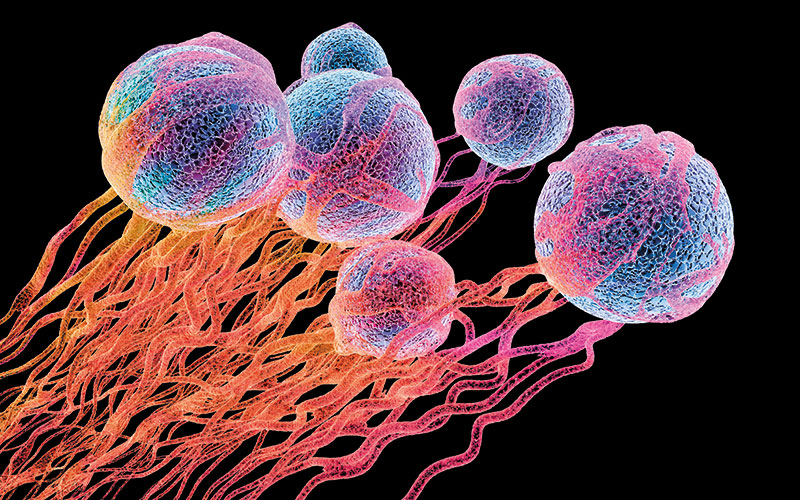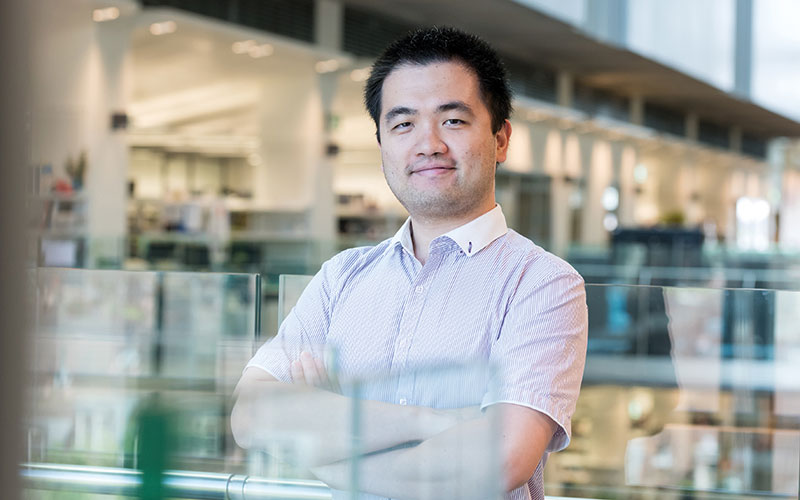Computational modelling has “provided a window into the evolution of a tumour”. Biological physicist Xiao Fu explains what this means for our knowledge of cancer progression.

Understanding how cancerous tumours evolve spatially and over time using real tissue is a complex process; it requires repeatedly taking multiple biopsies from various parts of a tumour. A computational model, however, developed by researchers at the Francis Crick Institute, the Royal Marsden NHS Foundation Trust and the Institute of Cancer Research, has identified links between tumour growth and shape, and how quickly a patient’s cancer might progress.
The study used mathematical modelling, combined with detailed clinical, molecular, histological and radiological data from 66 real-life tumours from the TRACERx Renal study to understand how tumours come about and evolve. Cross-referencing their mathematical model with the other data, the researchers examined two types of tumour growth in kidney cancers. In the “volume growth model”, growth is consistent throughout the tumour, whereas in the “surface growth model”, growth is restricted to the tumour’s surface.
They found that different rates of real-world tumour progression corresponded to different computational growth models. Tumours that rapidly progressed matched the scenario in the volume growth model where a single “fit” group of cells – which had gained an advantage through mutations that make them more likely to survive and divide even with low nutrient or oxygen levels – was present early on.
Impact of tumour growth on shape
Tumours that did not progress appeared to demonstrate that the original group of parental cancer cells remained dominant rather than a “fit” group forming – another scenario of the volume growth model. Extensive genetic diversity was found in the surface growth model of tumour progression, with different groups of “fit” cells forming on the tumour’s surface. This suggests the creation of a competitive environment in which different groups of cells are pushed to evolve more rapidly.
The model also provided insights into how different types of growth in tumours have an impact on their shape. Volume growth tumours grew outwards in a more consistent shape, while surface growth tumours showed bulges on the surface where the “fitter” groups of cells were forming.
“While investigating these two distinct growth patterns, we noticed a clear difference between the morphologies of the tumour surface, such as the budding structures in the surface growth model in contrast with the volume growth model,” says Dr Xiao Fu, first author of the study.
“When we split the entire patient cohort into rapid [cancer] progression versus attenuated progression it matched what we would expect from the surface growth and volume growth. That part of the analysis was the most surprising and exciting,” he adds. “One particular point that’s really interesting and also opens doors for future research opportunities is the coupling of tumour morphology and evolutionary features such as the clonal diversification. By simulation we were able to actually simulate in a single evolutionary history of a particular simulated tumour how the clonal diversity could evolve over time.”
“More research is needed but [this structural information about tumours] could be used to help determine what sort of growth a tumour is undergoing, for example, if radiological imaging of an early tumour shows bulges this means it’s more likely to be undergoing surface growth. This information could help inform medical teams and treatment decisions.”
Impact of necrosis on tumour growth
The study followed a 2018 paper that reported the evolutionary features of renal cell carcinomas in the TRACERx renal study, including varying structures of phylogenetic trees reflective of distinct modes of tumour evolution. “We were wondering what could be the driving mechanism for those,” says Fu, who was trained in biological physics, focusing on building computational models to study diseases including liver diseases caused by paracetamol overdoses and eye diseases including diabetic retinopathy, during his PhD study.
“As a computational modeller, from my background, what I was really curious about was how the growth in a spatial context could lead to observation of distinct evolutionary features. Specifically for renal cell carcinoma, we were really interested in asking whether spatial growth patterns could influence the evolutionary trajectories [of tumours] and patterns [of clonal diversification] given all the other variables and parameters.”
The model was also used to analyse how necrosis affected the tumour’s evolution. Under the surface growth model, the tumours quickly developed more “fit” groups of genetically distinct cells. This could provide insight into the future trajectory of tumour growth.
“We were really excited to see the computational model under the necrotic condition, where we could clearly see a collapse or reduction of clonal diversity at a later stage of the simulation,” Fu says. “This provides unique insights when we think about the static evolutionary snapshot of certain tumours.”
Xiao Fu

2008-12, BSc, physics, Nanjing University, China
2012-17, PhD, physics, Indiana University Bloomington, US
2013-17, Research Assistant, Biocomplexity Institute, US
2017-present, Postdoctoral Training Fellow, Biomolecular Modelling Laboratory and Tumour Cell Biology Laboratory, The Francis Crick Institute
Next steps
Fu says the findings are “just the start of what we hope to uncover,” and further collaboration is needed with the radiomics team at the Institute of Cancer Research to have a more comprehensive characterisation of any possible correlation between tumour shape and evolutionary pattern. “This will potentially extend the existing computational model to study more diverse patterns,” he adds.
Fu is also looking at slightly different computational models to study the evolution of lung cancers. “The computational field is moving in the direction of incorporating the impact of spatial context, spatial structure and spatial growth in tumours. Our work is adding to various other perspectives to show how the spatial growth could influence the measured or observed evolutionary trajectories, even without assuming a single cell-level difference.” He concludes: “It’s exciting to see how modelling can potentially help from a quantitative perspective in cancer research.”




